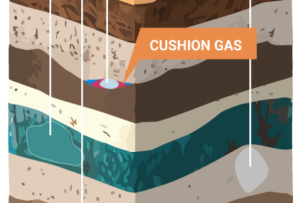What is underground hydrogen storage (UHS)?
We welcome any questions or general inquiries.
UHS involves storing large quantities of hydrogen gas in subsurface geological formations, such as salt caverns, depleted oil and gas reservoirs, or aquifers. This storage method offers a scalable and cost-effective solution for balancing hydrogen supply and demand. Learn more about the basics of underground storage here.
Glossary of Common Terms
(Click an icon in the illustration to learn more.)

 Salt Cavern
Salt Cavern
An artificial underground cavity created within a salt formation.
 Aquifer
Aquifer
Aquifers are permeable rock formations that contain underground non-drinking water. They can be converted for gas storage by injecting gas at high pressures, with the water and rock serving as condensure consistent deliverability during the withdrawal season.
 Depleted Reservoir
Depleted Reservoir
An oil or gas reservoir that no longer produces commercially viable amounts of hydrocarbons.
 Cushion Gas
Cushion Gas
Or base gas, is the volume of gas kept permanently in a storage reservoir to maintain pressure and ensure consistent deliverability during the withdrawal season.
 Working Gas
Working Gas
Working gas is the volume of gas stored in a reservoir above the base gas level, and it is available for use in the marketplace.
Is UHS safe?
Yes, when properly designed and managed, UHS is a safe and proven technology. Extensive research and operational experience from storing natural gas underground have demonstrated its safety and reliability. SUSTAIN H2 prioritizes safety through rigorous research and the development of best practices.
What are the environmental benefits of UHS?
UHS is a low-impact storage solution with a minimal surface footprint. It leverages existing geological formations, often repurposing depleted resources, and avoids the need for extensive land use or infrastructure development.
What are the challenges of UHS development?
UHS development faces technical challenges similar to the natural gas storage with specific questions related to hydrogen movement and loss during storage and withdrawal processes. Additionally, economic feasibility and regulatory considerations are important factors in UHS deployment.
How does SUSTAIN H2 address these challenges?
SUSTAIN H2 is actively working to address these challenges through collaborative research, data analysis, and evaluation of industry best practices. The initiative also assesses policy and regulatory frameworks to ensure the safe and responsible development of UHS.
What are the potential locations for UHS in the U.S.?
The U.S. possesses diverse geological formations suitable for UHS, including salt caverns in the Gulf Coast region, depleted oil and gas fields in various regions, and aquifers across the country. SUSTAIN H2 is conducting comprehensive assessments to identify the most promising locations for UHS development.
How can I get involved in SUSTAIN H2?
We welcome collaboration from researchers, industry leaders, policymakers, regulators, and other stakeholders interested in advancing UHS. You can get involved by contacting us through our website or attending our upcoming events.
Learn More
Contact the energy experts today

